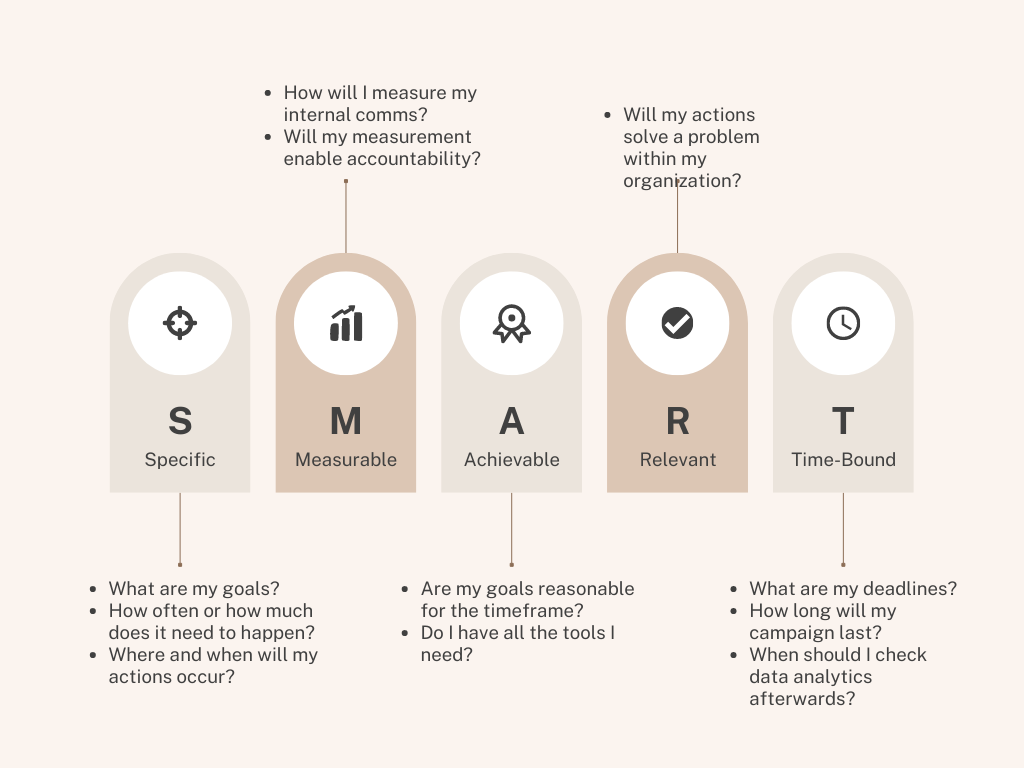Is it working? Measuring internal comms success
The variety of communications channels and forms of content available is greater than ever, so measuring internal comms success can be a significant challenge.
With social media alone encompassing high content volume platforms such as Facebook, Twitter and Instagram, there is huge competition for consumer attention. When you start to factor in tools designed for the digital working environment, it becomes clear that for your message to make a lasting impact, it needs to stand out.
Free ebook – 14 steps to great internal communications
Marketers and communicators globally already recognize the role and value of measuring and reporting on campaign success. It helps to identify channels and forms of content that work well; to identify potential ‘gaps’ in strategy; to refine and polish successful campaigns to deliver maximum value and return. By looking at the numbers, we can show what stands out in that sea of digital noise – and why.
Measuring internal comms
When it comes to internal communications, the value of measurement is just as important. If you are to understand what is (and isn’t) successful at engaging your employees and getting your message across, you need to delve a little deeper.
However, many operating in IC are still behind the curve when it comes to measuring and showing value.
There are many reasons why; a lack of available time or resource for reporting, perhaps, or the insufficient analytics or reporting tools attached to many internal communication platforms. If businesses don’t regard employees as a consumer of their content, they may not see the need to analyze its impact – we’ve done our duty in getting the message out, so what does it matter how many people read it?
This is where we need to adopt a mind-shift: something many leading communicators are already beginning to action. By backing up art with science, we can not only get more people engaging with what we’re sending out: we can have a measurable, tangible impact on strategic objectives including staff retention, employeee engagement, productivity rates and more.
But if you’re just starting out and wondering how to start measuring internal comms, the process can seem overwhelming. Here, we outline a simple approach to measuring what is important to your comms and your business as a whole.
Identify your KPIs
Before we can begin to effectively analyze data, we need to start by asking what success looks like. This will determine what specific information we need to gather, and how this will help measure performance.
This can be done by creating a series of questions, which you will use the acquired data to answer. These are normally aligned with wider departmental or organizational priorities: remember, the purpose is to demonstrate the business value which your communications activities are delivering.
Free ebook – 14 steps to great internal communications
For example, you may be looking to ascertain user engagement on your company intranet. Questions you might ask are:
- How many employees use the intranet?
- How regularly do they use it?
- Are there particular groups or demographics that use the intranet more or less than others?
- How are they engaging with content? (for example, are they reading, liking, sharing, commenting?)
- When are they using it? (Are there particular ‘peak times’ for usage, for example, or is there regular activity outside of core business hours?)
- How are they accessing it? (from their mobile device, work computers etc.)
Interact’s Analytics package, which offers insights including page visit numbers, user influence scores and active user numbers, is a powerful example of the information you can tap into. This can also be easily integrated with third-party tools such as Google Analytics, allowing you to monitor both your website and your intranet through the same interface.

By looking to wider business objectives, you can then determine what information is important. For example, if your organization is looking to increase engagement amongst remote workers, you can set a KPI against the number of visits amongst this particular employee demographic.
Other examples could be monitoring clicks or opens on internal emails, or responses and questions on discussion forums. If you are starting from scratch, consider collaborating with your external communications or marketing colleagues. Many existing digital marketing tools, like email automation software, can be repurposed for internal purposes; and offer useful ready-built insights and analytics for a starting point.
Whatever key performance indicators you decide on, make sure that they adhere to the SMART acronym: they should be specific, measurable, attainable, realistic and timely. For the example above, this may take the following format:
“Increase total user visits amongst remote workers by 15% between Q1 2017 to Q3 2017.”

Establish appropriate milestones by which to gauge and track what progress you make as the weeks and months pass!
Create a plan and be responsive
Once KPIs have been defined, the next step is to create, and stick to, a reporting plan.
Your plan should define the qualitative information which is most pertinent to your objectives, and offer the flexibility to adapt to changing departmental demands or goals.
Free ebook – 14 steps to great internal communications
An ideal reporting structure is cyclical. It isn’t realistic to expect perfection from your first plan or set of KPIs: none of us get it right first time. As you begin measuring and reporting, objective should be refined through the four-step process of: Plan; Test; Measure; Repeat.
Review your KPIs and goals regularly. You may discover that there isn’t an effective way of gathering qualitative data for one of your KPIs, or that it is no longer relevant. In this instance, it would be worth considering modifying or replacing this objective with one more appropriate or commensurate with your overall goals.
By implementing a framework which organically champions continuous improvement, you are ensuring that your KPIs and assessment metrics remain closely linked to what is important to your business, irrespective of change, and demonstrating the value of the work and role of internal communications in the business.
Hire a data analyst
While not all organizations will have the resource to hire a dedicated Communications Analyst, having someone in your team who understands the plan, your KPIs and how to interpret the pertinent data is crucial for successfully measuring performance.
Saskia Hoppe, Senior Manager of Communication Analytics at Coca Cola Enterprises Ltd, describes her role as “asking the right questions that will help my internal communications colleagues provide better, more engaging and more convincing communications”.
A dedicated analyst has the capability to fully evaluate the effectiveness of any campaigns, establishing whether objectives were achieved (and to what extent), before using that data to weed out any ineffective communications channels. Interpreting data and establishing what has been successful means that the entire team can focus their effort on worthwhile actions, rather than wasting time on ineffective activity.
What does success look like?
Every business is different. As such, every set of KPIs is likely to be different too. What was hailed as ‘success’ for internal communications one month may be considered unsuccessful the next, depending on changes in your business and its goals.
Data measurement and analysis is an environment of continuous change. Your objectives should reflect this, evolving and changing as required – be that informed by business decision or the results of the measuring activity itself.
Ultimately, measuring internal comms can help you better understand your audience and engineer the department’s approach accordingly. When this results in higher engagement rates and employee productivity, your communications department have demonstrable business value.

